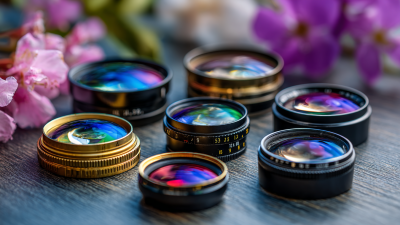The optical lenses industry is on the brink of transformative innovations that promise to reshape vision technology. As vision correction remains a crucial aspect of healthcare, the global optical lenses market is projected to reach USD 30 billion by 2026, growing at a CAGR of 5% according to a recent report by Grand View Research. These advancements not only enhance the functionality and comfort of lenses but also improve visual performance and health outcomes for millions of users worldwide.

Dr. Emily Clarke, a leading expert in optical technology, emphasizes the role of innovation in this field, stating, "The future of optical lenses lies in the integration of smart technologies and user-centric design, paving the way for customized solutions that meet diverse vision needs." As new materials and manufacturing techniques emerge, the potential for personalized and adaptive optical solutions becomes a reality, allowing for lenses that can adjust to varying lighting conditions or individual vision patterns.
As we delve deeper into the future of optical lenses, it becomes clear that the convergence of technology and design will not only redefine how optical lenses are manufactured but also revolutionize how we perceive and interact with our visual environment. This exploration of innovations in optical lenses will highlight the trends that are shaping the industry and the implications for consumers and professionals alike.
The realm of optical lenses is witnessing a transformative phase, driven largely by emerging materials that promise to enhance both design and functionality. Innovations such as high-index plastics and advanced coatings enable lenses that are lighter, thinner, and more durable. According to a recent report by the Optical Society, the global optical lens market is projected to reach $24 billion by 2025, highlighting the growing demand for sophisticated lens technologies that cater to diverse visual needs.
Engineered materials like Trivex and polycarbonate not only provide significant weight savings but also superior impact resistance, making them ideal for eyewear applications. Furthermore, advancements in anti-reflective and polarization coatings have revolutionized lens performance, improving clarity and reducing glare. Research indicates that lenses with these enhancements can increase customer satisfaction by over 30%, as they provide clearer vision and greater comfort in various lighting conditions.
Tip: When choosing optical lenses, consider options with advanced coatings that reduce glare and enhance contrast, especially if you often work in bright environments or use digital screens for prolonged periods. Prioritize lightweight materials for everyday wear to increase comfort without sacrificing visual quality.
The rapid advancement of digital technology is revolutionizing the field of vision correction, particularly through the development of smart lenses. These innovative optical devices merge traditional lens functionality with digital enhancements, allowing wearers to experience a new level of visual clarity and interactivity. By integrating features such as augmented reality, these lenses can overlay crucial information onto the real world, thus transforming the way individuals interact with their environment.
Smart lenses also promise significant improvements in user comfort and convenience. Equipped with sensors, these lenses can adjust to changing light conditions automatically, reducing glare and enhancing contrast based on the user's surroundings. Additionally, some models offer the capability to monitor health metrics, providing wearers with insights into their eye health and overall well-being. This seamless blend of vision correction with digital technology not only enhances the user's experience but also opens new avenues in personalized eye care, making smart lenses a pivotal innovation in the future of optical technology.
This chart illustrates the investments made in various segments of vision technology, showcasing the growing emphasis on innovations like wearable tech, smart glasses, and augmented reality, which are transforming how we perceive vision correction and patient monitoring.
The advent of enhanced optical coatings marks a significant milestone in the evolution of vision technology. These advanced coatings are designed to improve light transmission, which directly contributes to clearer and more vibrant images. By employing innovative materials and processes, manufacturers can create lenses that reduce glare and minimize reflections, allowing for more accurate color representation and greater visual comfort. This is particularly important in environments with challenging lighting conditions, where enhanced visibility is crucial for everyday tasks.
Moreover, the durability of optical coatings has seen substantial improvements. New formulations are crafted to resist scratches, chemicals, and environmental factors that can compromise lens integrity over time. This advancement not only extends the lifespan of optical devices but also assures users of consistent performance. As a result, these coatings are not just enhancing the user experience; they are paving the way for more robust optical solutions that can withstand the rigors of daily use. Ultimately, these innovations in optical coatings are transforming lenses from mere tools for vision correction into advanced technologies that significantly elevate visual experiences.
| Innovation Type | Description | Light Transmission (%) | Durability (Scratch Resistance) | Application Areas |
|---|---|---|---|---|
| Anti-Reflective Coatings | Reduces glare and enhances contrast | 98% | High | Eyewear, cameras, electronic displays |
| Photochromic Lenses | Adjusts tint in response to UV light | Up to 90% | Moderate | Sunglasses, safety glasses |
| Blue Light Blocking Coatings | Reduces blue light exposure from screens | 95% | High | Computer glasses, gaming glasses |
| Hydrophobic Coatings | Repels water and prevents smudges | 97% | Very High | Sports eyewear, outdoor applications |
| Anti-Fog Coatings | Prevents fogging in humid conditions | 93% | Moderate | Ski goggles, safety glasses |
The advancements in optical lens technology are revolutionizing how we perceive the world, particularly through the development of personalized vision solutions. Customizable lenses are emerging as a game-changer, allowing individuals to address their unique vision challenges. With innovations like digital eye scans and 3D printing, manufacturers can create lenses tailored to the specific refractive errors and lifestyle needs of the wearer. This not only enhances comfort but also significantly improves visual clarity.
Moreover, the emphasis on individual preferences extends beyond basic vision correction. Today, lenses can be designed to filter out harmful blue light or adjust to varying light conditions, catering to the diverse demands of modern life. These innovations make it possible for users to benefit from enhanced productivity and decreased eye strain, ultimately leading to a better quality of life. As the industry continues to evolve, the focus on personalization will likely reshape the landscape of optical products, ensuring that everyone can find a solution that truly meets their vision needs.
In recent years, the optical lens industry has witnessed a transformative shift towards sustainability, embracing eco-friendly innovations that not only enhance vision technology but also reduce environmental impact. Manufacturers are increasingly prioritizing the use of recycled materials and renewable resources in lens production. For instance, advancements in bioplastics and algae-based materials have opened up new avenues for creating lightweight and durable lenses while minimizing carbon footprints. This sustainable approach also extends to the entire lifecycle of lenses, from production to disposal, ensuring that they contribute less to landfill waste.
**Tips for Eco-Friendly Lens Choices:** When selecting eyewear, look for brands that champion sustainability in their manufacturing processes. Opt for lenses made from recycled materials and those that offer recycling programs after their lifespan. This conscious choice not only supports eco-friendly initiatives but often leads to superior quality and performance in vision technology.
As the demand for green technology rises, the optical lens industry is poised for even more innovations. Companies are exploring energy-efficient production methods and reducing water usage during manufacturing. Such practices not only help in sustaining the environment but also appeal to consumers who are increasingly aware of their ecological footprint, ultimately driving a shift towards a more sustainable future in vision technology.
**Tips for Sustainable Care:** To prolong the life of your lenses, invest in proper lens cleaning and storage solutions. Avoid using harmful chemicals for cleaning, and choose eco-friendly products instead. A little care can reduce waste and contribute to a cleaner planet.







